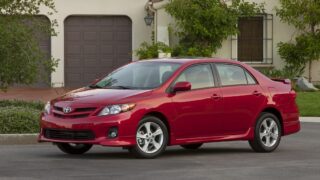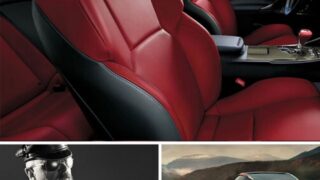2011 Lexus CT 200h Overview
The 2011 Lexus CT 200h is an all-new five door hatchback, or compact
wagon, powered by a hybrid gas electric powertrain. As with the Toyota
Prius, you do not plug this car in. Instead, you fill the tank with gas.
It’s propelled at times by both the electric motor and its
four cylinder engine, but at low speeds can run in electric-only mode.
Overview
The CT 200h is the fifth Lexus hybrid, and it’s the smallest. The CT 200h powertrain is taken from the Prius.
The Lexus CT 200h looks like no other Lexus, except from the front. It’s quite an attractive car, with smooth and flowing lines, from the contours on the hood up to the long roofline and straight back to the spoiler with a cool little lip over the muscular liftgate. The details of the design, trim and wheels are flawless.
The CT 200h is actually 4 inches shorter than the Prius, or the same overall length as the Audi A3 wagon. Its shape looks more European than Japanese, and its profile from all angles is very similar to that of the Audi. The coefficient of drag is a low 0.29, as much of the aero design was decided by wind tunnel testing.
Inside is a comfortable driving seat and a cozy cabin. The driving position was designed to enable easy access to the instrument panel and center stack, which is sloped at about a 45-degree angle. We found everything easy to reach. The steering wheel is slightly flat bottomed, making climbing in and out a little easier. Rear seat legroom is tight and cargo space is average for a compact sedan, but small for a hatch. The view rearward is restricted, so we recommend the rearview camera that comes with the optional navigation package.
You can get real leather if you need it, in black or beige, but standard equipment is a Lexus material we like called NuLuxe that is cheaper and friendlier to the environment, and probably nobody will ever notice it’s not leather. Interior trim can be matte wood, silver metallic or bamboo. Still thinking of the environment, much of the plastic on the CT 200h is vegetable based.
Fuel economy is an EPA-estimated 43 mpg City, 40 mpg Highway. During our daylong test, which included around-town cruising, a hard charge up a curvy mountain road, and 75-mph running on the freeway, we averaged 30.1 mpg. Other drivers got 30-35 mpg that day. Meanwhile, we watched the instantaneous fuel mileage, indicating that 40 mpg would take highly conscientious driving, with a very light foot.
With the Prius powertrain, the CT 200h makes 98 horsepower from the 1.8-liter Atkinson Cycle gas engine and 80 hp 60 (kW) from the generator, for a total of 134 hp. That’s not much, and 0-60 acceleration time of 9.8 seconds, a lethargic pace, and same as the Prius, reflects that. A driver may be lured into treating the car in a sporty manner, but the small engine and electronically controlled continuously variable transmission cannot respond to that urge.
We were surprised and delighted to discover the CT 200h handles very well. The handling is wonderful, spirited and secure around corners. Ride quality is very good. We drove hard over a section of road with a lot of lumpy tar patches, and our Lexus took them in stride. The other keys to this impressive balance are a high level of torsional rigidity, a double-wishbone rear suspension, a low center of gravity, a centralized moment of inertia, and sophisticated performance dampers. The CT 200h benefits from a tight turning circle: It can make a U-turn in just 34.2 feet, so city driving will be a breeze. The brakes are firm, too.
It is very quiet inside the cabin; at 75 mph on the freeway you can’t hear the engine at all. But it growls and works when you’re accelerating to 50 mph, for which you need at least Normal mode, unless you have all day. Eco mode is good to an easy 25 mph. An EV model allows all-electric operation at low speeds for short distances, so you’re not burning gas in heavy traffic. A new Braking mode uses deceleration forces to help recharge the battery more quickly.

Model Lineup
The Lexus CT 200h ($29,120) comes standard with automatic dual-zone climate control with dust and pollen filter, NuLuxe-trimmed seats, leather-trimmed steering wheel, 10-way power driver seat, four-way manual front passenger seat, fold-flat rear seats, SmartAccess key system with pushbutton start, steering wheel audio controls, manual tilt and telescope steering wheel, Bluetooth wireless connectivity for streaming audio and hands-free phone, power locks with anti-lockout feature, power windows, power mirrors, cruise control, keyless entry, six-speaker AM/FM/CD system with MP3 and USB/iPod inputs, WMA capability, integrated XM Satellite Radio receiver with complementary 90-day subscription, 12-volt power outlet, automatic headlights, first aid kit, heated mirrors, illuminated glove box, 17-inch alloy wheels.
The Premium model adds heated front seats and moonroof.
Options include rearview camera with compass, auto-leveling LED headlights with washers. The Premium Audio Package upgrades to a 6CD premium audio system with 10 speakers, rearview mirror with compass and HomeLink.
The Navigation Package includes HDD navigation system, rearview camera, enhanced Bluetooth, Lexus Enform with destination assistance, Lexus Insider, remote touch navigation controller, voice-command recognition, XM NavTraffic and Weather and Sports and Stocks, compass delete.
The Leather Package features perforated leather-trimmed seats, memory for driver seat, rain-sensing wipers, auto-dimming outside mirrors with memory.
Safety features include frontal airbags, side and knee airbags in front, full-length curtain airbags, electronic stability control, anti-lock brakes with brake assist, traction control, whiplash injury lessening seats, Safety Connect with automatic collision notification, stolen vehicle location, emergency assist button and enhanced roadside assistance. Optional safety features include the rearview camera and the Pre-Collision System with Dynamic Cruise Control.
Walkaround
One can’t say that the Lexus CT 200h looks like no other car, but it does look like no other Lexus. Some would call it a hatchback. It’s a five-door, or small wagon. Its overall length is the same as the Audi A3 wagon, and its profile from all angles is very similar. Its shape looks more European than Japanese.
It’s quite an attractive car, with smooth and flowing lines, from the contours on the hood to the tidy shoulders, up to the long low roofline and straight back to the spoiler with a cool little lip over the muscular liftgate. The radio antenna adds to the coolness by being located there, rear center. It says Hybrid on the side, in discreet but clear chrome letters.
The only Lexus badge is in front, inside the dark grille pushed forward of the headlamps, and its chrome badge. Lexus describes the nose much more vividly than we might: The grille incorporates a deeper, more sculpted interpretation of the L-finesse signature arrowhead motif, they say. The upper and lower grilles combine to form a unique spindle shape, bringing both bold simplicity and elegant dynamism to the very apex of the vehicle.
The coefficient of drag is a low 0.29, as much of the aero design was decided by wind tunnel testing. Computerized Fluid Dynamics, it’s called. More attention to detail: there are no less than nine tweaks under the car, to smooth the airflow.
The details are flawless, if not exceptional. Handsome 10-spoke 17-inch alloy wheels, impressive headlights either with single halogen or twin LED low beams, LED DRLs, black lower airdam, tidy foglights, compact aerodynamic sideview mirrors, a neat chrome outline around the windows, black B-pillar to blend with tinted glass, body-colored door handles, wide rear door openings, LED taillights with horizontal red brake-light stripes that curve around the edge of the car and up. That touch is unique, along with the C-pillar that defines the wagon part, wide at the top and bottom, a sort of distorted hourglass shape.
Interior Features
In the driver’s seat, the feeling is quite cozy and we found the fit snug. The first thing we noticed was our right knee crowded against the center stack tunnel. The steering wheel is actually flat-bottomed, just a teensy bit, to get maybe an inch more knee room, climbing in and out. And the driver’s seat slides way back.
But be careful with your back-seat passenger’s toes. There’s only 32.9 inches of legroom back there.
The cockpit grew on us, and felt less cramped by the end of the day, although not quite airy and spacious as Lexus calls it. We appreciated such an easy reach to the controls on the panel. It’s less distracting, thus safer. The center stack angles downward from the dash to the console, rather than dropping vertically; it’s more of a center slope than a center stack. It must be part of the design to more highly focus the controls on the driver, or vice-versa.
The view rearward is a bit pinched, as well. Rounded edges around the liftgate window, rear headrests rising into the picture, even the wiper blade, all restrict visibility.
You might end up thinking of your CT as a light aircraft, to be piloted with efficiency. Especially when you grab the one control that’s not tidy, a big fat T-handle for the shift lever, located up high where an airplane joystick might be. Lexus calls it highly tactile, but we’d just call it big and wide and chrome-looking. Or maybe it’s just evidence that the car is not highly focused on shifting gears. Except reverse, which it reminds you you’re in with incessant dinging of a bell, as if the Lexus were a fork lift. Do we really need this? We think not.
You can get real leather if you need it, in black or beige, but standard equipment is a Lexus material we like called NuLuxe, which is cheaper and friendlier to the environment, and nobody will ever notice it’s not leather, probably not even you after a while. It comes in Black, Ecru (gray) or Caramel. Interior trim can be matte wood, silver metallic or bamboo. Still thinking of the environment, much of the plastic on the CT 200h is vegetable based.
Every hybrid maker has their own ideas about how to display eco-driving information. They’re still trying to find what hybrid drivers like, or want, by doing different designs. Put it this way: with the Lexus, you won’t get a bunch of pictures of leaves and stuff. The gauges that show or tell you the things you might watch are clear and easy to access. For example whether you’re in Eco, Normal or Power mode; and fuel mileage right now, recently, and since you started this trip or last reset it. Also the battery status, when it’s charging and when it’s drawing.
We drove models with the optional 40GB navigation, and without. The eight-inch screen flips up on the dash, and the functions are controlled with a mouse-like thing called Remote Touch that’s easy to use, good ergonomics. The system includes all the music storing options you could think of, and voice recognition in three languages, but the navigation itself got us lost the one time we used it, probably because we used a POI without a street address. It sent us to a similar place 3 miles away, via I-10 instead of the short route which happened to be a scenic tour down Dinah Shore Blvd.
Models without the navigation system use a different center console. Lexus conveniently provides a slot on the center console for a portable navigation device (or cellphone), on models without the available navigation system. It’s a whole different console, in fact: thinner, with two cupholders fore and aft rather than side-by-side.
The forward ends of door pockets are slim, while the back part is shaped for a bottle. Good armrests with good grab handles on the doors.
The batteries live behind the back seat and under the cargo compartment, and probably raise the floor just a bit. It’s above your knees, when loading things in the back, and only 26.2 inches from floor to roof. The cargo ara is high and small, in other words. The double wishbone rear suspension increases the cargo volume to the sides a bit, in the absence of strut towers. There’s 14.3 cubic feet of storage space behind the rear seat, about the size of the trunk in a compact sedan, but a lot less than the 19.5 cubic feet the A3 manages to find. Lexus stats don’t include how much space is gained when the rear seat is dropped flat.

Driving Impressions
The differences between Eco, Normal and Sport modes are not in their limit to power, but in how fast it will take you to that limit, as in throttle response. Acceleration. Full-throttle acceleration from 0 to 60 takes 9.8 seconds, according to Lexus. That’s the same performance as the Prius, and it’s a long time when you’re trying to get on the freeway in front of a big truck traveling at least that fast. That’s in Sport mode.
Around town, below 25 mph, Eco mode is fine. You might even find you can often use EV mode, or all-electric vehicle power. Lexus says the CT 200h can go for one mile at 28 mph in EV mode on a full battery charge. That’s a useful feat in heavy, stop-and-go traffic. And the battery is easily charged by the brakes. Battery capacity is 650 volts and output is 36 kW.
There’s a new Braking mode, which gets the most out of regenerative brake energy to build up the battery charge. You can definitely feel it, because it slows down the car faster when you back off. Ironically, it slows the car down too fast, around the city when you want that battery all charge up; you can’t coast or glide as far. But it’s great when you’re driving down a curvy mountain. Or on a busy freeway. When you get there you’ll have a full tank of battery juice. Use it wisely.
Fuel economy for the CT 200h is an EPA-estimated 43/40 mpg City/Highway or 42 mpg Combined. It runs on regular 87-octane gasoline.
Using the Prius powertrain, the CT 200h makes 98 horsepower from the 1.8-liter Atkinson Cycle gas engine and 80 hp (60 kW) from the generator, for a total of 134 hp. That’s not much.
The Audi A3 makes about 50-percent more power from its 2.0-liter turbo, but gets a much worse 22/28 mpg driving with the automatic, 21/30 mpg with the manual 6-speed. A better comparison might be to the front-wheel-drive A3 turbodiesel with direct injection, which makes 140 horsepower and gets 30/42 mpg City/Highway. Plus, it has the great DSG transmission, and still costs less than the Lexus. With its low emissions (although not as low as a hybrid) it was the 2010 Green Car of the Year, from Green Car Journal.
It’s very quiet inside the CT 200h cabin; at 75 mph on the freeway you can’t hear the engine at all. But it growls and works when you’re accelerating to 50 mph, for which you need at least Normal mode, unless you have all day. Eco mode is good to an easy 25 mph.
The turning circle is a tight 34.2 feet, making city driving a breeze. Ride quality is good, also. We ran hard over a section with a lot of lumpy tar patches, and our Lexus took them in stride. The brakes are firm, too. And if you’re not gliding to stops in the city, using Braking mode helps. Imagine a small Jake brake, like the big trucks have.
Too bad the CVT intrudes upon enjoyable acceleration. As its name suggests, this is a Continuously Variable Transmission. It doesn’t have gears like a normal automatic or manual. It would be nice to have steps and paddles to shift sequentially, like other cars with CVTs have. Which, granted, might not be possible with a hybrid powertrain.
Driving up the mountain, the engine rpm’s kept surging, to maintain speed, as the CVT demands. It was annoying. It felt like an automatic transmission repeatedly kicking down. However it was all aural, as there is no actual surge felt in the car. Only the engine is surging.
We switched on the optional 10-speaker premium sound system, and turned the volume way up when we found The Who doing Quadrophenia, and like magic the perceived surging stopped, because we couldn’t hear it. We watched the tach, and it kept radically jumping up and down. The car was totally smooth. This weirdness is why people have a hard time with CVTs. The CVT relationship isn’t between speed and rpm, like we’re used to, it’s between acceleration and rpm, and it’s sensitive and sometimes extreme. We extended our test of this aspect of the CVT. Out on the open freeway, in Sport mode, the tach needle was barely 2000 rpm at 77 mph, and when we accelerated just a bit to 80 mph it leaped to 5000 rpm, with redline at 5500. We got to 82 mph and it maintained that speed at 3500 rpm. Even playing around like that, we got 30 mpg for those few miles.
The driving modes are further divided into Dynamic (Sport) and Relaxing (EV, Eco and Normal). Ironically, Dynamic is by far the most relaxing because it offers the most power. Lexus must have named those categories from the car’s point of view, not the driver’s.
We’ve saved the best for last. The handling is wonderful. It’s no accident; at the launch, Mr. Satakata the chassis engineer spoke of his work to make the CT 200h feel spirited and secure around corners. Torsional rigidity is addressed at every chassis opportunity, and there’s a double-wishbone rear suspension, low center of gravity, centralized moment of inertia (like a horizontal center of gravity), and performance dampers (first seen on the Toyota Corolla GTS), which are horizontal bars with a gas shock absorbers mounted between the front strut towers and rear frame horns. But Satakata-san’s work is unrequited, if not wasted. He needs to get the powertrain guys on his page. If Lexus made a CT 200 without the h, and with the IS 250 engine, it would be a star. They already do make one of those in Japan.
Summary
The Lexus CT 200h is an idea whose time has come. A Prius with the luxury and status of a Lexus, plus better looks and more cargo space, for a price that’s lower than a fully optioned Prius. The CT 200h handles well and rides nicely. It’s quiet underway when cruising. The CT 200h gets an EPA-estimated 43/40 mpg City/Highway.
Sam Moses filed this report after his test drive of the CT 200h in Southern California.
By Sam Moses of New Car Test Drive





